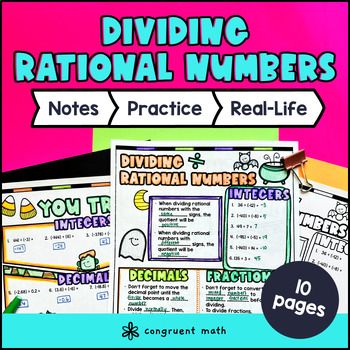Want more ideas and freebies?
Get my free resource library with digital & print activities—plus tips over email.
Join for Free Resources →
$4.25
Ever wondered how to teach dividing rational numbers, including fractions, integers, and decimals, in an engaging way to your middle school students?
In this lesson plan, students will learn about dividing rational numbers and their real-life applications. Through artistic and interactive guided notes, check for understanding questions, a color by code activity, and a maze worksheet, students will gain a comprehensive understanding of dividing rational numbers.
The lesson culminates with a real-life example that explores how dividing rational numbers can be applied to splitting a bill at a restaurant.

$4.25
After this lesson, students will be able to:
Before this lesson, students should be familiar with:
As a hook, ask students why dividing rational numbers, including fractions, integers, and decimals, is important in real life. Refer to the real-life math application on the last page of the guided notes as well as the FAQs below for ideas.
Use the guided notes to introduce the concept of dividing rational numbers. Walk through the key points of the topic, including the steps and techniques involved in dividing rational numbers. Refer to the FAQ below for a walk through on this, as well as ideas on how to respond to common student questions.
Based on student responses, reteach concepts that students need extra help with. If your class has a wide range of proficiency levels, you can pull out students for reteaching, and have more advanced students begin work on the practice exercises.
Have students practice dividing rational numbers including fractions, integers, and decimals using the color by code activity included in the resource. Walk around the classroom to answer any student questions and provide assistance as needed.
Fast finishers can work on the maze activity for extra practice. You can assign these activities as homework for the remainder of the class.
Bring the class back together, and introduce the concept of rational number division applied to splitting a bill with friends. Refer to the FAQ for more real life applications that you can use for the discussion!
If you’re looking for digital practice for dividing rational numbers, try my Pixel Art activities in Google Sheets. Every answer is automatically checked, and correct answers unlock parts of a mystery picture. It’s incredibly fun, and a powerful tool for differentiation.
Here's an activity to try:
A fun, no-prep way to practice dividing rational numbers is Doodle Math — they’re a fresh take on color by number or color by code. It includes multiple levels of practice, perfect for a review day or sub plan.
Here's an activity to try:
Dividing rational numbers involves dividing numbers that can be expressed as fractions or decimals. It is the process of finding how many times one number can be evenly divided by another number.
To divide fractions, you multiply the first fraction by the reciprocal (flipped) form of the second fraction. This can be done by multiplying the numerators together and the denominators together. Simplify the resulting fraction if possible.
Dividing decimals is similar to dividing whole numbers. Use long division to divide the decimal dividend by the decimal divisor. Place the decimal point in the quotient directly above the decimal point in the dividend.
Yes, you can divide positive and negative rational numbers. The rules for dividing positive and negative numbers are the same as for multiplying them. The result of the division will have a positive quotient if both numbers have the same sign, and a negative quotient if the numbers have different signs.
The main difference is in the representation of the numbers. Dividing fractions involves dividing numbers expressed as fractions, while dividing decimals involves dividing numbers expressed as decimal numbers. The processes and calculations are similar, but the final answers may be in different forms.
Dividing rational numbers is commonly used in real-life situations such as dividing the bill for a pizza among friends, calculating the cost per unit of a product, or determining the average speed of a moving object. It helps in solving problems that involve sharing, distributing, or comparing quantities.
One tip for dividing rational numbers is to always simplify the fraction before dividing. This makes the calculation easier and reduces the chances of errors. Additionally, keeping track of the signs (+/-) and placing the decimal point correctly when dividing decimals will help in obtaining accurate results.
Common mistakes to avoid when dividing rational numbers include forgetting to simplify the fraction, reversing the order of the fractions when finding the reciprocal, misplacing the decimal point when dividing decimals, and forgetting to consider the signs of the numbers being divided.
Yes, there are various resources available for practicing dividing rational numbers. This lesson plan includes guided notes, practice worksheets, color by code activities, and a real-life math application.
Get my free resource library with digital & print activities—plus tips over email.
Join for Free Resources →